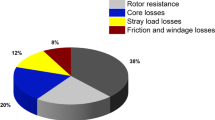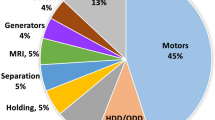Abstract
The transition of the automotive industry towards electro-mobility is highly dependent on the performance of batteries. Those batteries need a temperature management system, often realized as sheet metal cold plates with integrated channel structures for liquid cooling. Rollbonding technology is one of the most promising methods for industrial mass production of battery cooling systems in the automotive industry due to its competitive cost for low and high-volume applications and its great degree of design freedom. Designing cold plates is a challenging task due to conflicting thermal and hydraulic objectives, manufacturing requirements and the enormous design freedom offered by the rollbondig technology. Topology optimization is a well-known method for optimal design in multi-physics problems, such as cold plate design. Using a thermofluid topology optimization, the optimum channel patterns in a given design space can be found. However, the industrial application of such a design approach is challenging, as well-established topology optimization software often is designed for a wide variety of applications and, therefore, lacks manufacturing constraints and parametrization strategies feasible for the specific production process. This paper demonstrates how well-known parametrization and optimization strategies can be combined and adapted to generate topologies feasible for the manufacturing of cold plates by rollbonding. The integration of commercial solvers into an external, solver agnostic framework, considering custom manufacturing, continuation and filtering strategies is demonstrated. A density-based topology optimization is applied to the linear potential Darcy flow model, considering length scale constraints on the solid and fluid domain. A specific constraint is developed to assure the manufacturability of the design using the rollbonding technology. Further, a feasible continuation strategy considering projection parameters, penalization and length scale constraint activation and continuation is presented. The temperature distribution is optimized while considering pressure drop and manufacturing requirements. The topology optimization results are remodeled and validated using a high-fidelity RANS solver. The thermal-hydraulic performance is compared with a manually designed benchmark cold plate. Finally manufacturability of the outcomes is evaluated to prove the successful application of the proposed design technology.





















Similar content being viewed by others
References
Bendsoe MP, Sigmund O (2004) Topology optimization: theory methods and applications. Springer, Berlin
Bruns T (2007) Topology optimization of convection-dominated, steady-state heat transfer problems. Int J Heat Mass Transf 50(15):2859–2873. https://doi.org/10.1016/j.ijheatmasstransfer.2007.01.039
Dienemann R, Schewe F, Elham A (2022) Industrial application of topology optimization for forced convection based on darcy flow. Struct Multidisc Optim. https://doi.org/10.1007/s00158-022-03328-4
Dilgen C, Dilgen S, Fuhrman D (2018) Topology optimization of turbulent flows. Comput Methods Appl Mech Eng 331:363–393. https://doi.org/10.1016/j.cma.2017.11.029
Dilgen S, Dilgen C, Fuhrman D (2018) Density based topology optimization of turbulent flow heat transfer systems. Struct Multidisc Optim 57(5):1905–1918. https://doi.org/10.1007/s00158-018-1967-6
Ghasemi A, Elham A (2020) A novel topology optimization approach for flow power loss minimization across fin arrays. Energies 13:1–20. https://doi.org/10.3390/en13081987
Ghasemi A, Elham A (2021) Multi-objective topology optimization of pin-fin heat exchangers using spectral and finite-element methods. Struct Multidisc Optim 64:2075–2095. https://doi.org/10.1007/s00158-021-02964-6
Ghasemi A, Elham A (2022) Efficient multi-stage aerodynamic topology optimization using an operator-based analytical differentiation. Struct Multidisc Optim 65(4):130. https://doi.org/10.1007/s00158-022-03208-x
Guest JK (2009) Imposing maximum length scale in topology optimization. Struct Multidisc Optim 37(5):463–473. https://doi.org/10.1007/s00158-008-0250-7
Guest JK (2009) Topology optimization with multiple phase projection. Comput Methods Appl Mech Eng 199(1):123–135. https://doi.org/10.1016/j.cma.2009.09.023
Johnson SG (2023) The nlopt nonlinear-optimization package. http://github.com/stevengj/nlopt/
Khan HA, Asim K, Akram F (2021) Rollbonding processes: state-of-the-art and future perspectives. Metals. https://doi.org/10.3390/met11091344
Othmer C (2008) A continuous adjoint formulation for the computation of topological and surface sensitivities of ducted flows. Int J Numer Methods Fluids 58(8):861–877. https://doi.org/10.1002/fld.1770
Rojas-Labanda S, Stolpe M (2015) Automatic penalty continuation in structural topology optimization. Struct Multidisc Optim 52:1205–1221
Sigmund O (2007) Morphology-based black and white filters for topology optimization. Struct Multidisc Optim 33(4):401–424. https://doi.org/10.1007/s00158-006-0087-x
Sigmund O, Petersson J (1998) Numerical instabilities in topology optimization: a survey on procedures dealing with checkerboards, mesh-dependencies and local minima. Struct Optim 16:68–75
Svanberg K (2002) A class of globally convergent optimization methods based on conservative convex separable approximations. SIAM J Optim 12(2):555–573. https://doi.org/10.1137/S1052623499362822
Wang F, Lazarov B, Sigmund O (2011) On projection methods, convergence and robust formulations in topology optimization. Struct Multidisc Optim 43:767–784. https://doi.org/10.1007/s00158-010-0602-y
Yang K, Fernandez E, Niu C (2019) Note on spatial gradient operators and gradient-based minimum length constraints in simp topology optimization. Struct Multidisc Optim 60(1):393–400. https://doi.org/10.1007/s00158-019-02269-9
Zhao X, Zhou M, Sigmund O (2018) A “poor man’s approach’’ to topology optimization of cooling channels based on a darcy flow model. Int J Heat Mass Transf 116:1108–1123. https://doi.org/10.1016/j.ijheatmasstransfer.2017.09.090
Zhou M, Rozvany G (1991) The coc algorithm, part ii: topological, geometrical and generalized shape optimization. Comput Methods Appl Mech Eng 89(1):309–336. https://doi.org/10.1016/0045-7825(91)90046-9
Zhou M, Lazarov BS, Wang F (2015) Minimum length scale in topology optimization by geometric constraints. Comput Methods Appl Mech Eng 293:266–282. https://doi.org/10.1016/j.cma.2015.05.003
Funding
No external funding was received for the preparation of this paper.
Author information
Authors and Affiliations
Corresponding author
Ethics declarations
Conflict of interest
The authors declare that they have no conflict of interest..
Replication of results
We are confident that the paper contains sufficient detail on methodology and implementation, that the results can be re-created. In case of questions or difficulties, readers are welcome to contact the authors.
Additional information
Responsible Editor: Kai James
Publisher's Note
Springer Nature remains neutral with regard to jurisdictional claims in published maps and institutional affiliations.
Rights and permissions
Springer Nature or its licensor (e.g. a society or other partner) holds exclusive rights to this article under a publishing agreement with the author(s) or other rightsholder(s); author self-archiving of the accepted manuscript version of this article is solely governed by the terms of such publishing agreement and applicable law.
About this article
Cite this article
Schewe, F., Fleischer, D. & Elham, A. Industrial application of thermofluid topology optimization to rollbonding cold plates with dedicated manufacturing constraints. Struct Multidisc Optim 66, 230 (2023). https://doi.org/10.1007/s00158-023-03695-6
Received:
Revised:
Accepted:
Published:
DOI: https://doi.org/10.1007/s00158-023-03695-6




